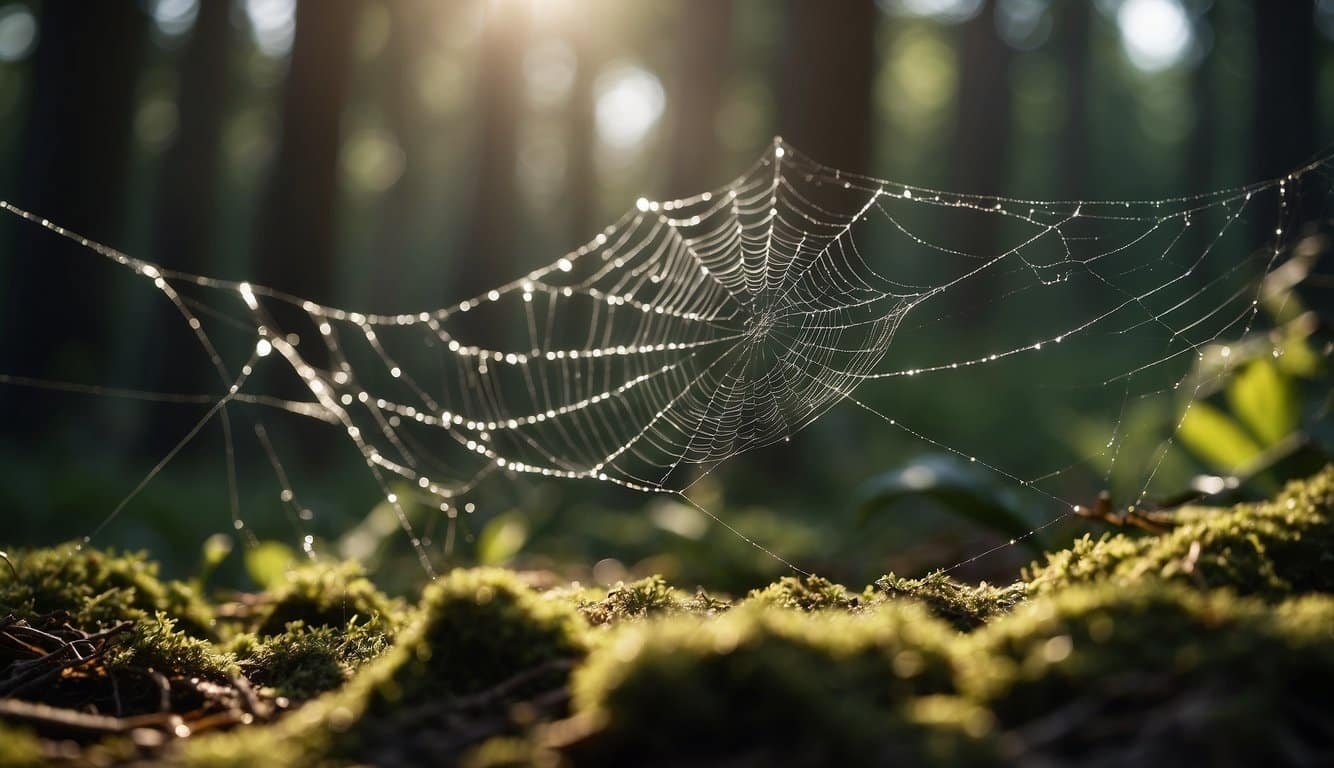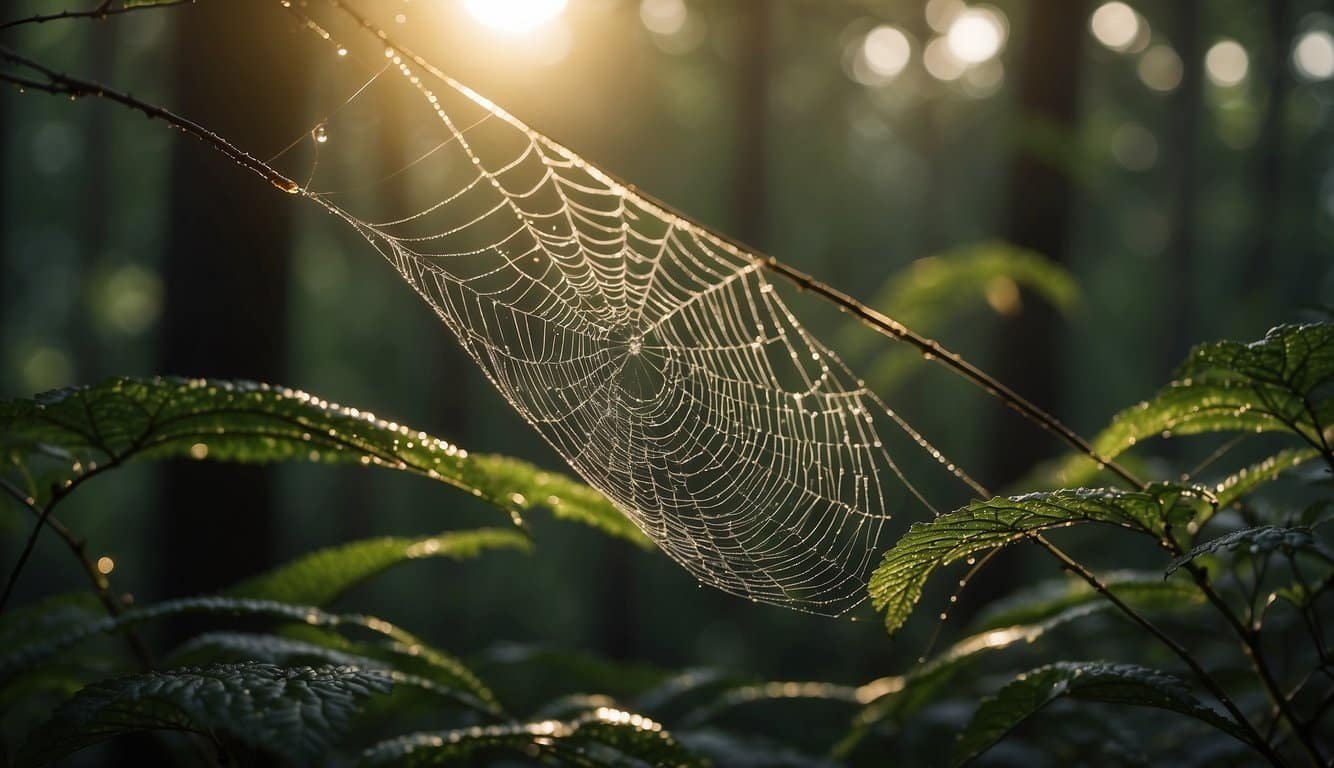The Science of Spider Webs
Spider webs are marvels of biological engineering. Each web is an intricate structure tailored to the unique predatory strategy of its creator, spun from silk that combines lightweight with exceptional strength.
Types and Structures
Spiders utilize a variety of web structures tailored to their ecological niche. The well-known orb web is crafted by species like the garden spider, its circular grid designed to capture flying insects. Less iconic but equally sophisticated, sheet webs cast a flat net, while tangle webs, or cobwebs, create a three-dimensional maze. Funnel webs lead prey into a trap, where the spider awaits hidden from view. Remarkably specialized, the sperm web is used by male spiders during reproduction.
The construction of these diverse architectures reflects the spider’s behavior, habitat, and the type of prey they pursue. Each species has perfected its own balance between energy investment and the likelihood of catching prey.
Material and Production
At the heart of web-making lies spider silk—a protein fiber produced from silk glands through organs called spinnerets. Depending on the spider’s needs, it synthesizes different types of silk. For example, cribellate silk lacks sticky properties and captures prey through a Velcro-like mechanism, requiring a specialized structure known as the cribellum.
Spider silk’s impressive tensile strength rivals that of steel, and its elasticity allows webs to absorb the impact of struggling prey. Minute spigots on the spinnerets control the silk’s deployment, with incredible precision in application and pattern. This allows spiders to optimally and economically use silk to construct their webs, repair damage, wrap prey, or even to sail through the air in a process known as ballooning.
Diversity and Functionality

Spider webs are more than just intricate traps for catching prey; they are expressions of evolutionary innovation. Each web is a testament to the diversity and functional prowess spiders have refined over millennia.
Web Variations Across Species
Different spider species construct a wide array of web architectures. Orb weavers, for instance, create the classic spiral wheel-shaped orb-webs often seen glistening with morning dew. The Uloboridae family, though, lacks venom and depends on non-sticky capture silk to immobilize prey. Theridiidae or cobweb spiders, including the well-known redback spider, construct tangled tangle webs or cobwebs, using sticky silk to effectively capture their victims. The Agelenidae family, known as funnel-web spiders, builds sheet-like webs with a funnel retreat where they await prey vibrations. On the larger side of the spectrum, Nephila, a genus of orb-weaver spiders, is known for its impressive size and web, which can catch prey as large as moths.
- Tetragnathidae, long-jawed orb weavers, often found near water, build delicate orb webs with an open center or hub.
- Linyphiidae, or sheet weavers, create dense sheet webs that can be found close to the ground or under leaves.
- Bolas spiders use a unique foraging method, where they swing a sticky bolas, a single or few sticky globules at the end of a silk thread, to capture moths that are lured by mimic pheromones.
The house spider and jumping spiders deviate from web-building, with the latter employing active hunting tactics over silk construction.
Adaptations and Uses
Spider webs are not solely for capturing prey. They serve various purposes like protective egg sacs for spiderlings, offering shelter, or even assisting in mate attraction for some species like bolas spiders and Nephila.
- Sticky droplets on catching threads are a quintessential adaptation in webs, effectively grabbing hold of flying insects.
- Trip threads warn some spiders, like the tarantulas, of nearing threats.
- Spiders like crab spiders and wolf spiders display minimal use of silk; they rely on their camouflage and agility rather than webs.
- Permanent structures are seen in spiders such as orb-weavers, while cobweb spiders frequently rebuild their webs.
Silk properties are meticulously tuned for specific functions such as elasticity, toughness, and adhesive strength. For example, the jumping spider uses silk as a lifeline when leaping, and the gumfooted lines of the theridiidae aid in trapping walking insects by collapsing under their weight. The diversity seen in the web structure and its functionalities highlights the impressive adaptability of spiders to their environments and target prey.
Interactions with the Environment

Spider webs are not just simple insect traps; they are intricate structures that can influence and reflect the ecosystems they are part of. Their presence demonstrates a fascinating interplay of biology and physics in the natural world.
Webs and Ecosystem Impact
Spider webs, whether they are the spiral orb webs of Araneidae or the dense tangle webs of Theridiosomatidae, play a crucial role in controlling insect populations. For example, the orb webs crafted by Araneus species can impact flying insect numbers in a garden, thereby influencing pollination dynamics.
On a smaller scale, the construction of sperm webs by male spiders is a critical part of their courtship rituals, affecting reproductive success. Even the types of webs, such as the funnel webs of Agelenidae or the tubular webs of Segestriidae, are examples of engineering mastery, each adapted to the environmental niche the spider occupies.
Some webs have special features; for instance, stabilimenta are web decorations that may have multiple functions, including attracting prey or providing camouflage. These features further highlight the relationship between spiders and their habitats.
Human Perceptions and Applications
Humans have drawn inspiration from spider webs for applications such as the creation of Velcro, a material that mimics the stickiness of spider silk. The robust yet flexible nature of spider silk intrigues engineers, leading to research into bio-inspired materials that could revolutionize construction and material science.
Moreover, species like the ogre-faced spiders (Deinopidae) or the triangle spiders (Hyptiotes) challenge human perceptions of web-building as they use their webs in dynamic and unusual ways to capture prey, showcasing the diversity and adaptability of web construction. The architectural prowess of these spiders extends to how they cope with environmental factors such as gravity, which in turn affects the structural integrity and placement of their webs.
Scientists also study spiders like Zygiella x-notata, which spins wheel-shaped orb webs with a missing sector, to understand the impact of urban environments on web construction, providing valuable insights into how nature adapts to human-altered landscapes. Studies on such interactions can often be found in databases like JSTOR.

